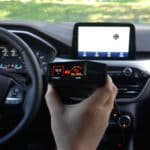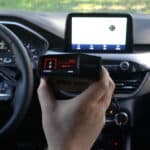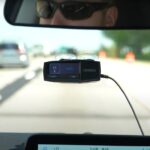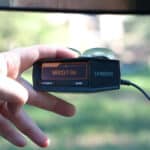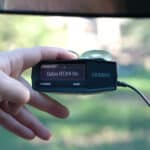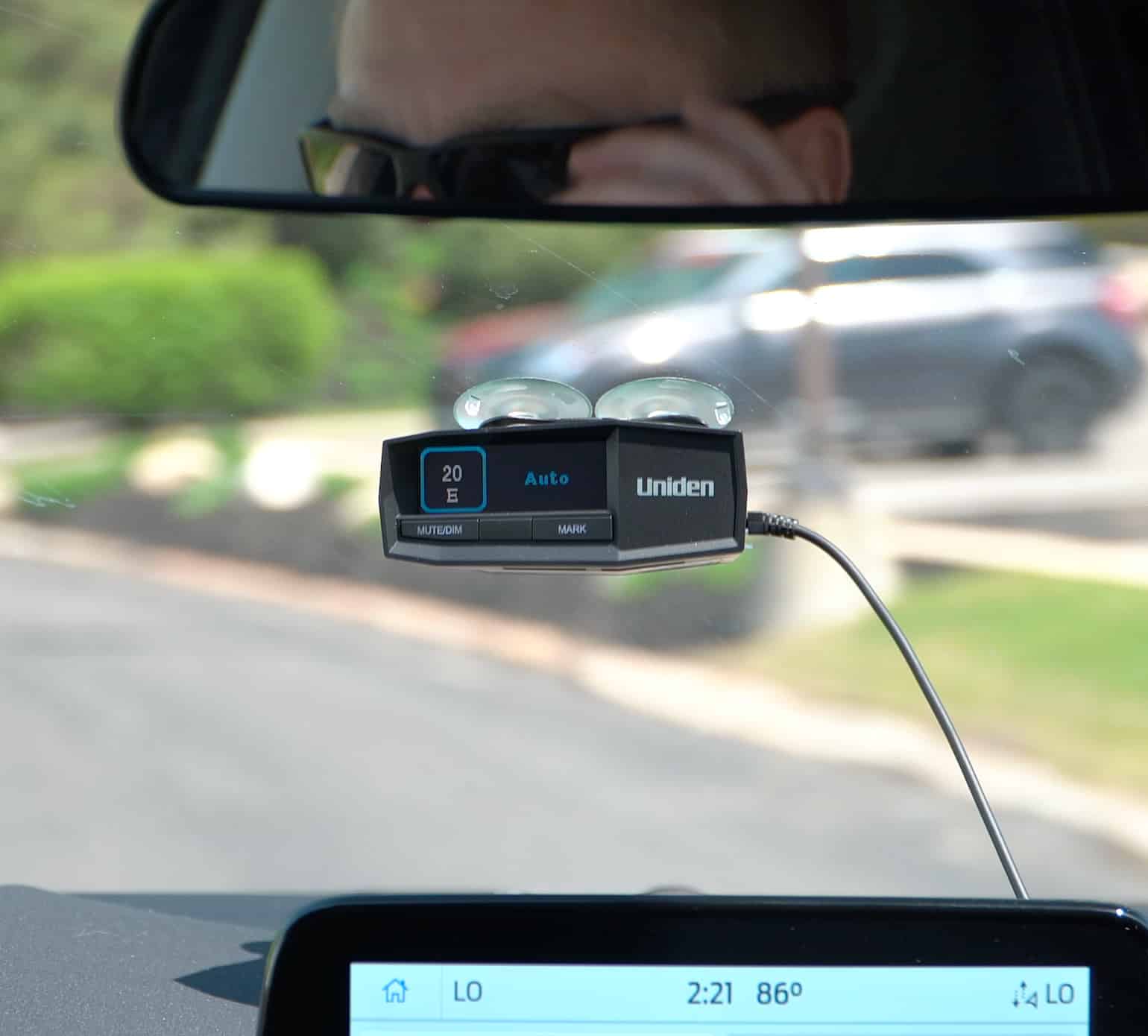Affiliate Disclosure: As an Amazon Associate, Automoblog earns from qualifying purchases. Commissions from Amazon and other affiliate partners come to us at no additional cost to you when making a purchase via this page. We bought the Uniden R8 here with our own money. See our Privacy Policy to learn more.
Uniden R8 Crash Course
- As the successor to the Uniden R7, the R8 is built on a new dual-antenna platform with two Low Noise Amplifiers (LNAs) to increase detection range.
- Key features include an Auto Sensitivity mode, segmentation filters, directional arrows, and Uniden’s signature All Threat display.
- The Uniden R8 is a good pick if you do a lot of highway driving, as the detection range is stellar. Not counting any deals or specials, the R8 usually retails for about $600 on Amazon.
- If you don’t mind spending the money, the Uniden R8 will give you the most situational awareness with the least amount of effort.
Our Review Process for Radar Detectors
Automoblog is a member of the Radar Detector and Countermeasures Forum to ensure truth and accountability when covering radar detectors.
Whether we receive a radar detector from a manufacturer to review or purchase it with our own money, there are four main points we consider, listed below. Our primary driving areas with any radar detector include the Detroit metro and the Ohio Turnpike.
Uniden R8 Review Summary (New Platform)
As its name suggests, the R8 is the updated version of the nearly immortal Uniden R7 radar detector. With big shoes to fill, the Uniden R8 comes to the party with an all-new platform, giving it an advantage over the R7 in terms of detection range and available features.
Fantastic Range Detection
Like the R7, the detection range sets the Uniden R8 apart from the competition, with the R8 receiving a boost over the R7 thanks to a new dual-antenna platform with two Low Noise Amplifiers (LNAs). Although the R7 is still a long-range legend, the R8 has become Uniden’s flagship detector and our top pick for highway driving.
New Features
In addition to stellar detection range, the R8’s new platform enables an Auto Sensitivity mode, a laser gun identification feature, Gatso detection, and an Auto Mute Memory function, also known as auto lockouts (although Uniden has since released a firmware update for the R7 that includes auto lockout capability).
Built-in GPS
The Uniden R8 includes a built-in GPS, which determines your geographic location and then identifies “set frequency locations” in your area from a database. Set frequency locations often include things like red light and speed cameras.
In this Uniden R8 review, we will take a more in-depth look at some of the key features and walk through the settings menu. A companion app for the R8 is available for iOS devices.
What’s In The Box?
The Uniden R8 comes with a 12V DC power cord with an RJ11 connector and USB port, hook and loop tape for dashboard mounting, and an owner’s manual.
The USB port is convenient as it allows you to charge a device even as the R8 occupies your vehicle’s 12V outlet, while the RJ11 connector supports Uniden’s wired keypad, similar to custom install units.
The Uniden R8 has audio and accessory jacks on its left-hand side and a micro USB port on its right-hand side just ahead of the power connection port. The audio jack supports a headset for motorcycle use, while the accessory jack is for Uniden’s upcoming laser jammers. The micro USB port connects the R8 to your computer for the latest firmware updates.
Included are two different windshield mounting brackets. There is a larger single suction cup bracket and a bracket with two smaller suction cups. Uniden includes a carrying case for the R8 with a Neoprene sleeve.
Uniden R8: Settings & Features
Here is a rundown of everything the Uniden R8 offers once it is attached to your windshield. As time has gone on, we have come to prefer the single larger suction cup mount as it seems less apt to wobble over bumps (the photos in this review are of the double suction cup mount).
With the Uniden R8, when it comes to switching off certain radar bands (like X bands in our case), sensitivity modes, and segmentation filters (covered more below), let where you drive determine your settings.
Radar & Laser Protection
The Uniden R8 will alert you to X, K, and Ka radar bands and laser (LiDAR) guns. New to the R8 is a laser gun identification feature that shows the type of gun law enforcement is using as the alert is received.
We have X bands turned off, but the Downriver communities south of Detroit use K band, so we are hesitant to have our R8 outright ignore K band.
This is something to be mindful of no matter which brand of radar detector you own or are considering buying. Where you live will determine the best settings for your radar detector. While it’s likely that most K bands are false, not all of them will be – and in a case like ours, you may drive in an area where law enforcement still relies on K band.
City, Highway & Auto Sensitivity Modes
Like the R7, the Uniden R8 has City and Highway modes, adding an Auto Sensitivity mode thanks to its new platform.
In City mode, X and K band sensitivity is reduced to minimize false alerts, while Ka bands stay at full sensitivity. In Highway mode, all bands go to full sensitivity to give you the most reaction time on the open road.
You can further optimize the R8’s sensitivity levels through the Advanced mode. Similar to the R7, you can adjust the Rear Balance of the R8 in the settings menu.
While we are still fond of our Uniden R7, the R8’s Auto Sensitivity mode is a welcome upgrade. Here in Detroit, we are often navigating stop-and-go traffic on main roads like M10, I-696, I-94, and Telegraph. Naturally, the Uniden R8’s detection range is something we appreciate in these areas, but a nice bonus is the Auto Sensitivity mode, or what we call a “set it and forget it” mode.
Auto Sensitivity is a speed-dependent mode that automatically switches back and forth between City and Highway at a preset speed. It’s a convenient feature if you find yourself in stop-and-go traffic or on any road where your speed can fluctuate at any one time.

Directional Arrows
When the R8 detects a radar source, it will flash a red arrow to indicate where it’s coming from. An upward arrow indicates the radar source is ahead of you, while a downward arrow indicates it’s behind you. Twin “side-by-side” arrows indicate the source is coming from the side. The twin arrows may also flash as you get closer to the radar source, suggesting it’s “all around you.”
Directional arrows set the R8 apart from something like the R4, a less expensive alternative in Uniden’s lineup. Although the R4 is a great radar detector in its own right, its single antenna design means it cannot distinguish where the radar source is coming from, just that it’s there.
Since the R8 has a dual-antenna design (one in the front and one in the rear), it can decipher where the radar source is located via directional arrows on the display. Directional arrows are non-negotiable for some as they provide a higher level of situational awareness and help justify the price of something like the Uniden R8.
OLED Display & All Threat
The R8’s OLED display is similar to the R7 and will show the frequency when a particular radar band is detected. The corresponding signal strength indicator moves from green to yellow and then to orange and red, depending on how close you are to the threat.
Audible alerts are issued simultaneously, with the tones becoming more rapid the closer you are to the radar source. You can set the R8 to announce the type and frequency of any radar bands you encounter. If so, it will also announce the direction.
There are three different alert displays to pick from in the settings menu, so play around and see which one you like best (this is a subtle upgrade as the Uniden R8 offers one more alert display than the R7).
Of course, no Uniden radar detector would be complete without the All Threat feature! Although the factory setting for this is off, it’s something we recommend switching on for increased situational awareness.
With the All Threat engaged, the R8 will simultaneously detect up to four radar bands, showing each of them visually on the OLED display. The strongest signal is designated as the priority and will appear front and center. Up to three other signals can appear on the left side of the screen in what resembles a little digital chart. This digital chart shows the individual radar band, its signal strength, and direction.
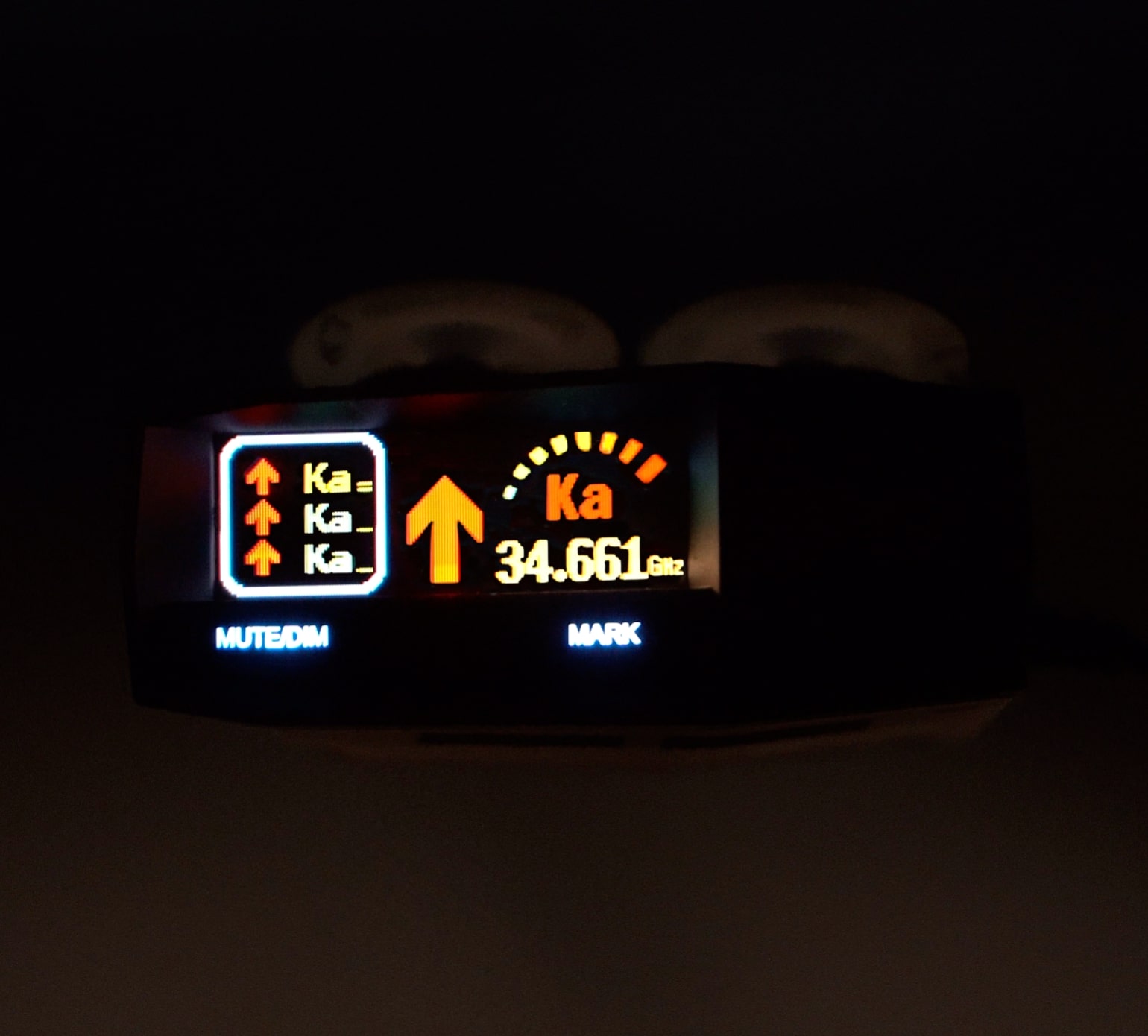
MRCD, MRCT, RT3 & RT4 Detection
The Uniden R8 detects POP transmissions (short, fast bursts), MRCD, MRCT, RT3, and RT4, with the latter two (RT3 and RT4) being the separate frequency ranges of Gatso radar used by the latest speed cameras.
When you are nearing a red light or speed camera, the R8 will flash a traffic light or camera icon on the display screeen along with the corresponding distance (in feet) as you approach the source.
A selling point of the Uniden R8 is its ability to alert to a wide variety of radar sources, from patrol cars and speed traps to traffic cameras and other photo enforcement devices. This, combined with its stellar range detection, makes the Uniden R8 one of the best radar detectors currently on the market.
Segmentation Filters
You can experiment with the K and Ka filters in the settings menu, including segmentation filters. To access the segmentation filters, change the “Mode Display” in the settings menu from “Basic” to “Expert.”
For K bands, the Uniden R8 gives you three segmentation filters: Wide, Narrow, and Extended. Wide and Narrow scan for K band radar guns used in the U.S. only, although Narrow does not scan as much of the available frequency range as Wide. Extended increases the frequency scanning range for K band radar guns to its maximum.
Here in Detroit, we are okay with setting the R8 to K Narrow, opening it up a bit to K Wide when we travel south into the Downriver communities, where we have verified K band threats visually. While driving in Detroit proper, K Narrow helps reduce false alerts. By contrast, K Wide in the Downriver area makes it so we are more apt to notice a legitimate threat.
As for the Uniden R8’s Ka segmentation filters, we also have that set to Narrow. In Narrow, the R8 scans only for U.S.-spec guns versus the entire Ka frequency range. Narrow can potentially reduce false alerts and provide a quicker response time since the R8 is not monitoring the full Ka frequency range.
There are nine different settings if you want to go deeper into the R8’s Ka Segmentation filters beyond Wide and Narrow. For additional insight on segmentation filters, also known as custom sweeps, Vortex Radar has an excellent guide on the topic.
In our experience, segmentation filters are a balancing act, and the best course of action for how to set them is based on where you live. If you want to tweak and experiment beyond the factory settings, remember that the ideal balance is having a radar detector that can filter false alerts and stay quiet while still alerting you to legitimate threats.
Additionally, the Uniden R8 has K Block filters, which help prevent false alerts caused by the blind spot monitors of other vehicles. These types of filters are sometimes called “bsm filters” for short.
Manual Mute Memory & Auto Mute Memory
The Mute Memory and Auto Mute Memory features provide an additional layer of functionality. Since the Uniden R8 has a built-in GPS, it remembers any place where the alerts are known to be false.
If you want to mute these false alert locations manually, press the Mute/Dim button on the front of the unit or the Mute button on the power cord. You will then see “Mute On” appear on the display. Press one of the buttons again to save that GPS location and frequency to the R8’s memory.
When you pass that location again, the R8 will display the alert and the frequency on the OLED display, but it won’t make a sound.
By contrast, you can rely on the Auto Mute Memory function that will, after a few passes, automatically lockout said false alert. We prefer to do this process manually, but the Auto Mute Memory feature can still be convenient on certain occasions.

User Marks
User Marks (also called location marking) work similarly to the Mute Memory functions, but you will use these for areas with a legitimate and recurring radar source (speed traps are a good example). Press the Mark button to save the location when driving by or through these particular areas. The R8 will issue a voice prompt the next time you are near that saved location to give you a heads-up.
One thing to note: you cannot save a new location if there is a previous User Mak within a 1,600-foot radius (we have never run into an issue with this).
Memory Quota
Memory Quota lets you set the individual number of Mute Memory and User Marks.
In total, the Uniden R8 can save up to 2,000 points between the two, but you can allocate that one way or another in 50-point increments. For example, we have our Mute Memory set at the maximum of 1,750 allotments, meaning we have 250 for User Marks.
We tend to encounter more Mute Memory locations here in Detroit, so we want the highest allotment possible. However, if we should need more room for User Marks, we could drop that allotment for Mute Memory in 50-point increments.
Is The Uniden R8 Worth The Money?
The Uniden R8 is one of the best radar detectors if you spend a lot of time on the highway; there is no question about it.
Twice a year, we drive to Minneapolis from Detroit for a business trip, which gives us time to evaluate products like radar detectors. Our route takes us west across Michigan on I-94, through Chicago, and then up through Wisconsin on I-90 on the way to Minnesota. On these long stretches of interstate, our R8 has given us at least a mile’s notice, if not more, when a state patrol vehicle is parked and monitoring traffic.
Add to that the R8’s directional alert arrows, Gatso detection, Auto Sensitivity Mode, and the All Threat feature, and it’s one of the best radar detectors you can buy.
If you purchase a Uniden R8 and have questions, join us on the forum, and we can point you in the right direction. Make sure to keep an eye on Uniden’s customer support website periodically for the latest firmware updates.
Carl Anthony is the Managing Editor of Automoblog and the host of AutoVision News Radio and AutoSens Insights. As a respected automotive industry thought leader, Carl has appeared on numerous podcasts and radio shows, including Wrench Nation, Cars Yeah, The Car Doctor, and Brains Byte Back, in addition to appearing as a regular contributor on MotorMouth Radio on WHPC 90.3 FM. His work can also be seen and heard 24/7 on the Automoblog YouTube channel.
Radar Detectors FAQ
Are Radar Detectors Legal?
Using a radar detector in a privately owned passenger vehicle is legal in the U.S., with the exception of Virginia and Washington D.C. Radar detectors are illegal in commercial vehicles. See this guide to radar detector laws for all 50 U.S. states if you have additional questions.
How Do Radar Detectors Work?
While proprietary technology can differ between each radar detector manufacturer, think of a radar detection device in terms of receiving and deciphering.
Every radar detector has a “horn” or antenna (sometimes more than one) and an internal microprocessor. The antenna picks up or receives the police radar gun, and the microprocessor deciphers it, ultimately showing on the display screen important info like signal strength and band type.
Radar detector manufacturers build on that basic principle with their own hardware and software to achieve increased detection range with fewer false alerts.
Will My Radar Detector Alert to Laser Guns?
Yes, all radar detectors will alert to police laser guns, meaning your radar detector is also a laser detector by default.
Some radar detectors are compatible with an accessory called laser shifters, but those are different from laser jammers, which are illegal in some states. Police laser guns use a technology called lidar, which stands for light detection and ranging.
What Is The Best Radar Detector For Me?
The best radar detector for you will depend on where and how you drive and how much you want to spend.
If you love having the latest and greatest gadgets, you might enjoy the features a high-end unit will provide. By contrast, if you only need a gentle reminder of police radar in the area, you can find something more basic but still of good quality.
Popular radar detector manufacturers today include Cobra, Escort, Radenso, Uniden, Valentine, and Whistler. Some high-performance radar detectors, like the Escort Redline 360c, are compatible with a smartphone app that shares user-generated alerts.
I Saw a Police Car, Why Didn’t My Radar Detector Alert?
Sometimes, a patrol car will have its radar gun off, meaning there is nothing for the radar detector to alert to. Traffic officers also use an enforcement strategy called “Instant-On” radar, where they only use their radar gun at certain times (think like the storied image of the officer on the motorcycle hiding behind the billboard).
If this happens, traffic officers will only target one vehicle at a time. Most high-quality radar detectors will alert to Instant-On radar with plenty of advanced notice, although it’s still possible to get a ticket via Instant-On if you are not careful. Instant-On radar is the opposite of “Always-On” radar.


















